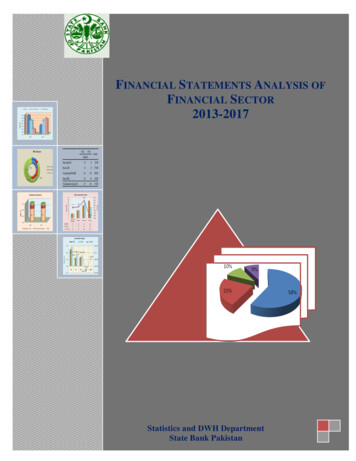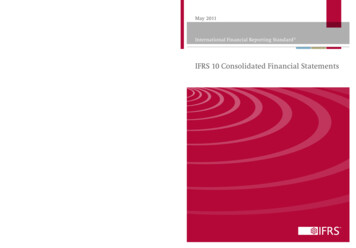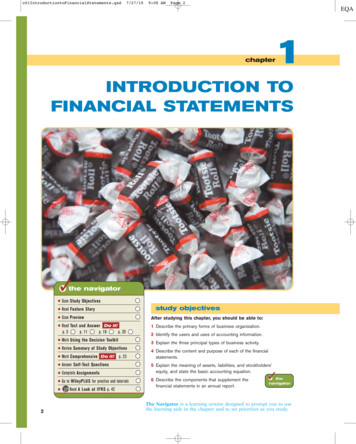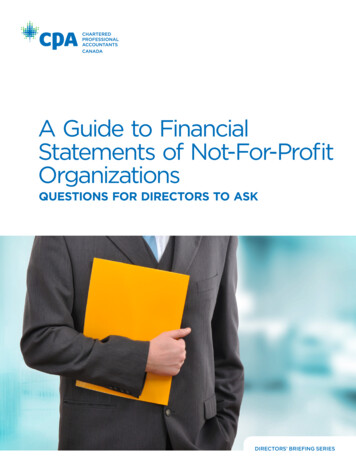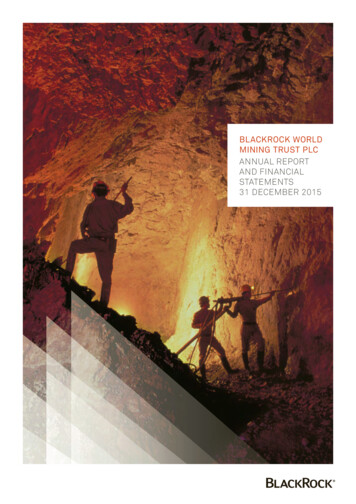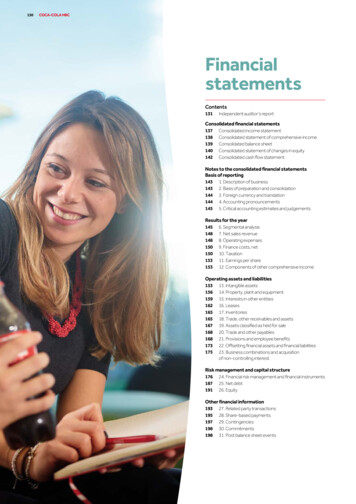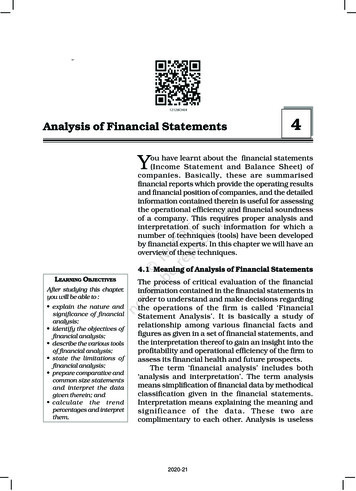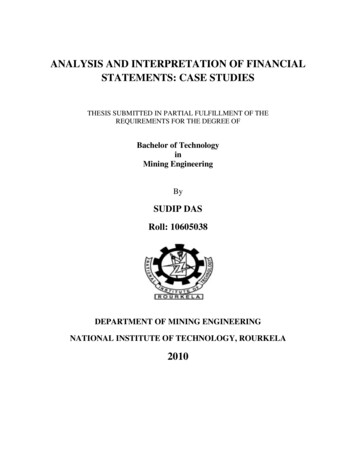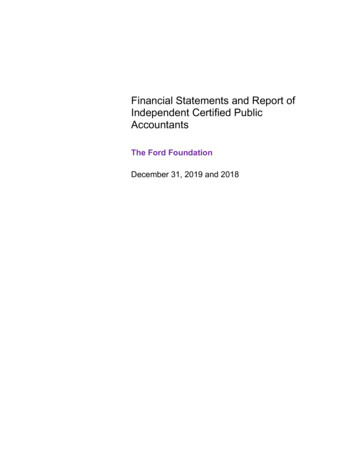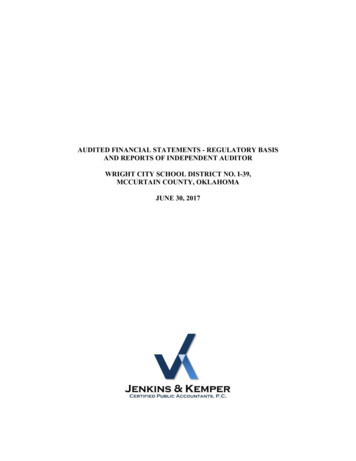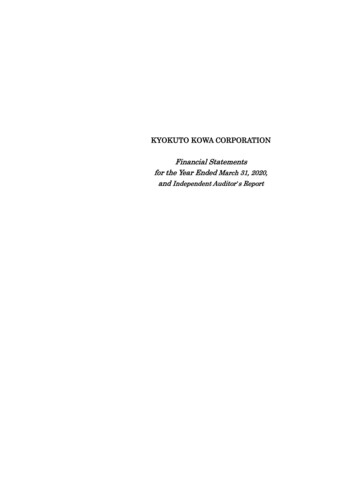
Transcription
KYOKUTO KOWA CORPORATIONFinancial Statementsfor the Year Ended March 31, 2020,and Independent Auditor’s Report
KYOKUTO KOWA CORPORATIONBalance SheetMarch 31, 2020Millions of Yen2020ASSETSCURRENT ASSETS:Cash and cash equivalents (Note 7)Receivables (Note 7):Trade notes (Note 3.b and 3.d)Electronically recorded monetary claimsTrade accountsParent company and affiliated companies (Note 8)OtherInventories (Notes 3.a and 3.c)Prepaid expenses and other current assetsTotal current assets 137Thousands ofU.S. Dollars(Note 1)2020 LIABILITIES AND EQUITYCURRENT LIABILITIES:Short-term borrowings from parent company (Note 7)Payables (Note 7):Trade notesElectronically recorded obligationsTrade accountsParent company and affiliated companies (Note 8)OtherIncome taxes payable (Note 7)Advances received on uncompleted construction contracts (Note 7)Provision for warranties for completed constructionOther current 397,1402,8113,48425,03326114,734135,383Total current liabilitiesPROPERTY, PLANT AND EQUIPMENT:LandBuildings and structuresMachinery and equipmentTools, furniture and fixturesTotalAccumulated 14622,0509,69163,396(43,786)2,13419,610LONG-TERM LIABILITIES:OtherTotal long-term liabilitiesTotal liabilitiesMillions of Yen2020 5,835Thousands ofU.S. Dollars(Note 1)2020 17,930593,18329,248 17,240 158,415CONTINGENT LIABILITIES (Note 3.b)Net property, plant and equipmentINVESTMENTS AND OTHER ASSETS:Investment securities (Note 7)Deferred tax assets (Note 6)Other assets (Note 8)Allowance for doubtful accountsTotal investments and other assets91107200(26)8409861,831(235)3723,422EQUITY (Notes 4, 5, and 9):Common stock—authorized, 30,000,000 shares; issued,8,620,000 shares in 2020Capital surplus:Additional paid-in capitalOther capital surplusRetained earnings:Legal reserveUnappropriatedUnrealized gain on available-for-sale securitiesTotal equityTOTAL 17,240TOTAL 158,415See notes to financial statements.- 1 -
KYOKUTO KOWA CORPORATIONStatement of IncomeYear Ended March 31, 2020Millions of Yen2020NET SALES (Note 8)Thousands ofU.S. Dollars(Note 1)2020 25,910 279COST OF SALES (Note 8)Gross profitSELLING, GENERAL AND ADMINISTRATIVEEXPENSES (Note 8)Operating incomeOTHER INCOME (EXPENSES) (Note 8):Interest and dividend incomeInterest expenseFinancing expensesOther—netOther income (expenses)—netINCOME BEFORE INCOME TAXES2( 42)( 20)( 10)21( 382)( 186)( 106)(70)( 653)1,048INCOME TAXESCurrentDeferredTotal income taxesNET INCOME 369( 2)3,387( 22)3673,365681YenPER SHARE OF COMMON STOCK (Notes 4 and 9):Basic net incomeCash dividends applicable to the yearSee notes to financial statements.- 2 -9,626 6,261U.S. Dollars 79.0517.00 0.730.16
KYOKUTO KOWA CORPORATIONStatement of Changes in EquityYear Ended March 31, 2020ThousandsOutstandingNumber ofShares ofCommonStockBALANCE, MARCH 31, 20198,620Millions of YenCommonStock 100Capital SurplusAdditionalOtherPaid-inCapitalCapitalSurplus 195 812Retained EarningsLegalUnappropriReserve-ated 118Net incomeCash dividends, 17 per shareNet change in the yearBALANCE, MARCH 31, 202018,620 100 919 195 812 118 1,951 7Thousands of U.S. Dollars (Note 1)Capital SurplusUnrealized GainAdditionalOtherRetained Earningson talSurplusReserve-atedSecurities 1,792 7,466 1,082Net incomeCash dividends, 0.16 per shareNet change in the yearBALANCE, MARCH 31, 2020 6681(146)CommonStockBALANCE, MARCH 31, 2019 1,416Unrealized Gainon Availablefor-SaleSecurities 13,015 566,261(1,346)3 919 1,792See notes to financial statements.-3- 7,466 1,082 17,930 59TotalEquity 2,647681(146)1 3,183TotalEquity 24,3306,261(1,346)3 29,248
KYOKUTO KOWA CORPORATIONNotes to Financial StatementsYear Ended March 31, 20201. BASIS OF PRESENTATION OF FINANCIAL STATEMENTSThe accompanying financial statements have been prepared from the accounts maintained byKYOKUTO KOWA CORPORATION (the "Company"), in accordance with the provisions set forthin the Companies Act of Japan and applicable regulations and in accordance with accountingprinciples generally accepted in Japan. The information provided in the notes to the financialstatements is limited to that required by the Companies Act of Japan and applicable regulations.Statements of comprehensive income and cash flows are not required as a part of the basic financialstatements under the Companies Act of Japan and applicable regulations and, accordingly, are notpresented herein.In preparing these financial statements, certain reclassifications and rearrangements have been madeto the Company's financial statements issued domestically in order to present them in a form which ismore familiar to readers outside Japan.The financial statements are stated in Japanese yen, the currency of the country in which theCompany is incorporated and operates. The translation of Japanese yen amounts into U.S. dollaramounts are included for the convenience of readers outside Japan and have been made at the rate of 108.83 to 1, the approximate rate of exchange at March 31, 2020. Such translations should not beconstrued as representations that the Japanese yen amounts could be converted into U.S. dollars atthat or any other rate.2. SUMMARY OF SIGNIFICANT ACCOUNTING POLICIESa. Inventories—Construction projects in progress, finished products, and work in process are statedat cost as determined by the specific identification method. Raw materials and supplies are statedat cost as determined by the moving-average method. The write-downs of inventories due todecreased profitability are reflected in the valuation of raw materials and supplies and theaccompanying loss is recognized as cost of goods sold, in principle.b. Property, Plant and Equipment—Property, plant and equipment are stated at cost. Depreciationis computed by the declining-balance method based on the estimated useful lives of the assets,while the straight-line method is applied to buildings, excluding building fixtures, acquired on orafter April 1, 1998. The range of useful lives is principally from 12 to 38 years for buildings andstructures and from 3 to 9 years for machinery and equipment and tools, furniture and fixtures.c. Long-Lived Assets—The Company reviews its long-lived assets for impairment whenever eventsor changes in circumstance indicate the carrying amount of an asset or asset group may not berecoverable. An impairment loss would be recognized if the carrying amount of an asset or assetgroup exceeds the sum of the undiscounted future cash flows expected to result from thecontinued use and eventual disposition of the asset or asset group. The impairment loss would bemeasured as the amount by which the carrying amount of the asset exceeds its recoverableamount, which is the higher of the discounted cash flows from the continued use and eventualdisposition of the asset or the net selling price at disposition.d. Investment Securities—Investment securities are classified and accounted for, depending onmanagement's intent, as available-for-sale securities. They are reported at fair value, withunrealized gains and losses, net of applicable taxes, reported in a separate component of equity.Nonmarketable available-for-sale securities are stated at cost determined by the moving-averagemethod. For other-than-temporary declines in fair value, investment securities are reduced to netrealizable value by an impairment charge to income.e. Allowance for Doubtful Accounts—The allowance for doubtful accounts is provided for at an-4-
amount sufficient to cover possible losses on collection. It consists of the estimated uncollectibleamount with respect to identified doubtful receivables and an amount calculated by applying thepercentage of actual losses on collection experienced in the past to the remaining receivables.f.Allowance for Losses on Construction Contracts—To cover losses which have a highprobability of occurring in the future upon work completion, an allowance for estimated losses isprovided based on the amount of orders received and the estimated cost.g. Provision for Warranties for Completed Construction —Provision for warranties for completedconstruction is provided for anticipated future costs within the warranty period arising fromwarranties on completed construction.h. Construction Contracts— In December 2007, the Accounting Standards Board of Japan (ASBJ)issued ASBJ Statement No. 15, "Accounting Standard for Construction Contracts," and ASBJGuidance No. 18, "Guidance on Accounting Standard for Construction Contracts." Under thisaccounting standard, construction revenue and construction costs should be recognized by thepercentage-of-completion method if the outcome of a construction contract can be estimatedreliably. When total construction revenue, total construction costs, and the stage of completion ofthe contract at the balance sheet date can be reliably measured, the outcome of a constructioncontract is deemed to be estimated reliably. If the outcome of a construction contract cannot bereliably estimated, the completed-contract method should be applied. When it is probable that thetotal construction costs will exceed total construction revenue, an estimated loss on the contractshould be immediately recognized by providing for a loss on construction contracts.The revenues recognized by the percentage-of-completion method for the year ended March 31,2020, were 18,268 million ( 167,859 thousand).i.Income Tax—The provision for income taxes is computed based on the pretax income includedin the statement of income. The asset and liability approach is used to recognize deferred taxassets and liabilities for the expected future tax consequences of temporary differences betweenthe carrying amounts and the tax bases of assets and liabilities. Deferred taxes are measured byapplying currently enacted income tax rates to the temporary differences.The Company's parent company files a tax return under the consolidated corporate tax system,which allows companies to base tax payments on the combined profits or losses of the parentcompany and its wholly owned domestic subsidiaries. The Company is included in theconsolidated corporate tax system.(Treatment of tax effects for transition from the consolidated corporate tax system to the grouptax sharing system)Regarding the transition from the consolidated tax system to the newly established group taxsharing system and the several changes to accounting policies of the single taxation systemfollowing the aforementioned transition under the act on partial revision of income tax act (ActNo. 8, 2020), the Company calculates deferred tax assets and liabilities based on the corporatetax law before revision, notwithstanding the provisions of section 44 of the ASBJImplementation Guidance on tax effects accounting (Guidance No. 28, February 16, 2018),pursuant to Section 3 of the ASBJ Practical Solution on the treatment of tax effects for thetransition from the consolidated corporate tax system to the group tax sharing system (PITF No.39, March 31, 2020).j.Per Share Information—Basic net income per share is computed by dividing net incomeavailable to common shareholders by the weighted-average number of common sharesoutstanding for the period.Cash dividends per share presented in the accompanying statement of income are dividendsapplicable to the fiscal year, including dividends accrued and paid after the end of the year.k.New Accounting Pronouncements—On March 31, 2020, the ASBJ issued ASBJ StatementNo. 29, " Accounting Standard for Revenue Recognition," and ASBJ Guidance No. 30,-5-
" Implementation Guidance on Accounting Standard for Revenue Recognition." The coreprinciple of the standard and guidance is that an entity recognizes revenue to depict thetransfer of promised goods or services to customers in an amount that reflects theconsideration to which the entity expects to be entitled in exchange for those goods orservices. An entity recognizes revenue in accordance with that core principle by applyingthe following steps:Step 1: Identify the contracts with a customerStep 2: Identify the performance obligations in the contractStep 3: Determine the transaction priceStep 4: Allocate the transaction price to the performance obligations in the contractStep 5: Recognize revenue when the entity satisfies a performance obligationThe accounting standard and guidance are effective for annual periods beginning on or afterApril 1, 2021. Earlier application is permitted for annual periods beginning on or after April1, 2018.The Company expects to apply the accounting standard and guidance for annual periodsbeginning on or after April 1, 2021, and is in the process of measuring the effects ofapplying the accounting standard and guidance in future applicable periods.-6-
3. NOTES TO BALANCE SHEETa. InventoriesInventories at March 31, 2020, consisted of the following:Thousands ofU.S. Dollars2020Millions of Yen2020Construction projects in progressFinished productsWork in processRaw materials and suppliesTotal 1,0221,4671271082,724 9,39213,4791,16599725,033b. Contingent liabilitiesThousands ofU.S. Dollars2020Millions of Yen2020Guarantees to loans from banks of the parentcompanyTrade notes endorsedTotal4. 4,850 1685,018 44,565 1,54146,106NOTES TO STATEMENT OF CHANGES IN EQUITYa. Type and number of outstanding sharesFor the year ended March 31, 2020Type of sharesNumber of SharesBalance atIncrease inDecrease inBeginning ofShares DuringShares DuringBalance atYearthe Yearthe YearEnd of YearIssued stock:Common stock8,620,000-7---8,620,000
b. Dividends(1) Dividends paid to shareholdersFor the year ended March 31, 2020Amount perAmountShareResolutionType ofMillions ofThousands o
The Company's parent company files a tax return under the consolidated corporate tax system, . following the aforementioned transition under the act on partial revision of income tax act (Act No. 8, 2020), the Company calculates deferred tax assets and liabilities based on the corporate tax law before revision, notwithstanding the provisions of section 44 of the ASBJ Implementation Guidance .
